Authors:
Historic Era: Era 3: Revolution and the New Nation (1754-1820s)
Historic Theme:
Subject:
Special Issue - George Washington Prize 2018 | Volume 63, Issue 2

Authors: Jennifer Van Horn
Historic Era: Era 3: Revolution and the New Nation (1754-1820s)
Historic Theme:
Subject:
Special Issue - George Washington Prize 2018 | Volume 63, Issue 2

In 1752, the British-born artist Joseph Blackburn painted a portrait of prominent Bermuda merchant and official Francis Jones. Seated at a table, Jones is shown hard at work on his correspondence; his writing set is positioned in front of him with a quill and a stick of red wax standing at the ready for the merchant to compose and then seal his letters. At the moment, however, the sitter grips an opened letter in his left hand and with his right points toward the window behind him. Jones’s gesture reminds the viewer of his commercial interests, symbolized by the ship sailing near the Bermuda coast. But his raised finger also calls attention to the pile of opened correspondence that sits before him.
Blackburn directs the viewer’s gaze between the ship and the papers by leading the eye from the vessel’s billowing white sails to the bright-white, ruffled cuff that descends from the wrist of the sitter’s pointing arm, then to the white feather’s parted barbs immediately beneath, and finally down the feather’s shaft to the pile of white letters that rests just beside the writing set. As this visual linkage suggests, these missives were as essential to Jones’s commercial success as the distant ship.
Blackburn’s painting celebrates Jones’s building of strong and far-reaching networks through his correspondence. Like other transatlantic merchants, Francis Jones relied upon a web of friends and associates for information; within his letters’ pages came details about prices at different ports, warnings about conflicts that might disrupt shipments and destroy vessels, and news of the creditworthiness of potential partners. Without the reliable list of prices his correspondents provided, the merchant could not position his own goods effectively at far-flung markets, and without the personal financial connections (built through correspondence) that enabled him to receive and to extend credit, the merchant could not operate. Nowhere is the importance of the letter and the networks that they helped to construct more evident than in Blackburn’s portrait of Jones.
Letters were equally important in the career of the artist who painted Jones’s portrait. Joseph Blackburn’s arrival in Bermuda in 1752 marked the start of a twelve-year North American sojourn during which the artist completed approximately one hundred portraits of sitters in Newport, Rhode Island, Boston, Massachusetts, and Portsmouth, New Hampshire. Letters proved a critical tool that enabled the British artist to penetrate new circles. Unknown in North American locales, Blackburn relied upon the recommendations sent
One such document survives, written by Newport merchant Thomas Vernon to his friend James Boutineau of Boston, husband of Susanna Faneuil of that city’s renowned Faneuil merchant family. Penned in November 1754, it is a letter of introduction, likely carried by Blackburn himself, as it “recommend[s] . . . the bearer Mr. Blackburne to your [Boutineau’s] favor and friendship.” Announcing Blackburn as “late from the Island of Bermuda a Limner [or artist] by profession . . . [who is] allow’d to excel in that science,” Vernon notes that, though Blackburn <“will be an entire stranger there . . . if suitable encouragements” are found, he proposes “to make some stay in Boston.” Thomas Vernon was well versed in the importance of correspondence both as a merchant and as the postmaster of Newport, a position to which Postmaster General Benjamin Franklin
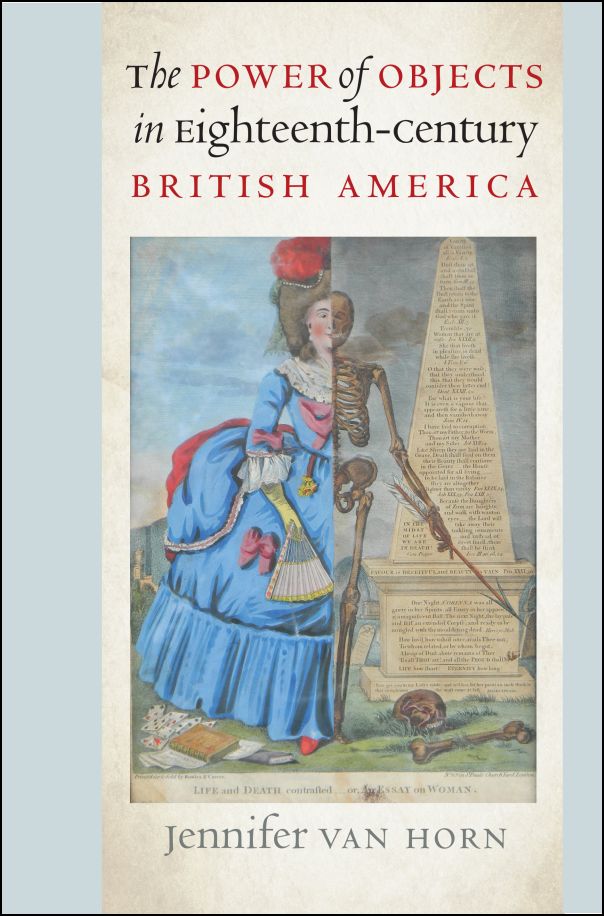
appointed him. Letters of introduction such as that Vernon wrote for Blackburn were a common means to vouch for the bearer’s character in a distant location where he was unknown and followed a common formula. Indeed, while in London, Franklin sent just such a letter to Vernon himself in 1770, informing him, “The Bearer Mr. Bowman, intends for New York; and as he will be intirely a Stranger in Rhode Island, I beg leave to recommend him to your Civilities as a young Gentleman of good Character, for whom I interest myself.” Like Franklin, Vernon gave his correspondent details about Blackburn’s polite character, informing his friend that the artist “has now spent some months in this place, and behav’d in all respects as becomes a Gentleman, being possess’d with the agreeable qualities of great modesty, good sence and genteel behaviour.” Such letters were the physical manifestations of long-distance networks upon which merchants relied.
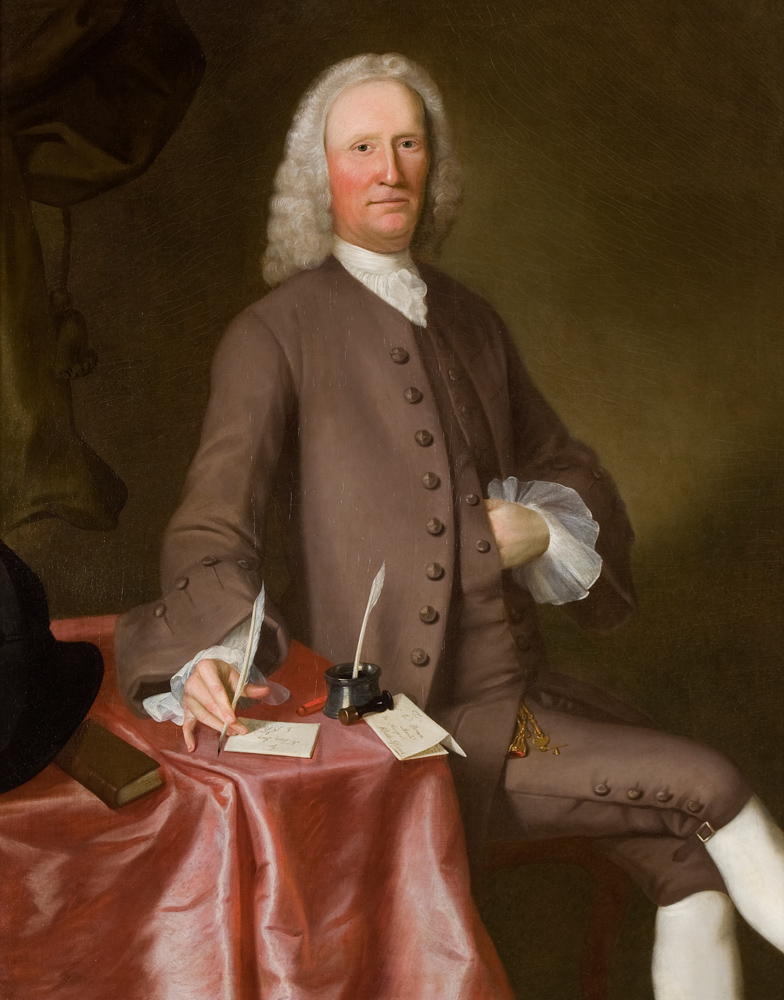
The letter of introduction not only made a stranger known to a new community but also called upon the deference and devotion that the reader had for the sender to show appropriate hospitality to the bearer. Franklin wittily reminded Vernon of this obligation, interweaving his injunction with his closing salutation, “Your Advice may be useful to him; and every Regard you shew him, will be acknowledg’d as an Obligation confer’d on, Dear Sir, Your most obedient humble Servant/B Franklin.” Vernon similarly warned Boutineau that, upon his next trip to Boston, he “expect[ed] to
Brown’s portrait, like Jones’s before it, incorporates writing implements and letters as critical components of the composition. Brown, seemingly interrupted in the act of addressing a letter, gracefully suspends a quill between the thumb and fingers of his outstretched right hand. A second quill draws the viewer’s attention to the inkwell, sealing wax, and seal arranged next to an opened letter that drapes intriguingly over the edge of the red, silk-covered surface. The merchant is addressing a missive to “Mr. Henry Sharp / Merchant / of St. Christopher [St. Kitts],” whereas the other document bears Brown’s own name and location. The painted letters, one from Brown and one to him, visually represent the merchant’s circuit of communication and of mutual favors. As Blackburn presented Vernon’s letter to Boutineau, Blackburn could expect that the system of debt and reciprocal obligation that marked merchants’ connections would lead Boutineau to offer the artist employment.
Like a merchant arriving at a port with goods to sell and a letter from a trusted acquaintance to recommend him, Blackburn used Vernon’s endorsement and his exhortations for patronage in order to advance along that trader’s network from the smaller port of Newport to Boston’s larger and potentially more lucrative market. In this instance, Boutineau appears to have shrugged off his friend’s request. No portraits of him or his family members painted by Blackburn survive. However, he–or others in his intimate circle–recommended Blackburn to new patrons, as several members of the Faneuil family had their portraits painted in Boston by the artist, who soon found flourishing sponsorship in the city. Blackburn likely exploited similar contacts a few years later, in 1760, when he moved from Boston to Portsmouth, New Hampshire, and continued to paint prominent mercantile families, many with Bermuda connections.
Boston and Portsmouth newspapers advertised unretrieved letters being held at local printers and addressed to Joseph Blackburn. The advertisements offer tantalizing evidence of the artist’s further use of correspondence to extend his trade and prepare the way for future ports of call. The notices suggest a web of correspondents akin to a merchant’s, if on a smaller scale. Indeed, in his portrait of Francis Jones, Blackburn also memorialized his own epistolary efforts. The artist included his name on one of Jones’s letters, inscribing his signature “J. Blackburn / Pinixit / 1752” (loosely translated from the Latin as “J. Blackburn painted this in 1752”) across the top of the paper. By conspicuously identifying himself as one of Jones’s correspondents, Blackburn impresses upon viewers that the artist not only was someone hired to paint Jones but also was part of Jones’s larger network. Blackburn, who likely met Jones in London while the merchant was there on legislative business, might well have exchanged letters with the Bermudian, either before his arrival on
The portrait of Francis Jones commemorates the importance of transatlantic networks of exchange, but beyond that, it announces itself as an entrant in these same networks. Like the merchant’s letters that Blackburn painstakingly portrayed, which were always written with the expectation of a reply, so, too, did the artist expect his portraits to generate an answering response in the form of future commissions from members of the merchant’s coterie. In a sense, Blackburn’s letter of introduction and his many pictures of merchants that bear painted letters were components of the same network. Blackburn’s paintings could be seen as the merchants’ responses to their friends’ written requests. The portrait of Francis Jones made an appeal to those mercantile associates who viewed the canvas: his friends should have their portraits painted by the artist. The painting also anticipates their answer: just as his associates’ letters rest in Jones’s depiction, signifying the merchants’ mutual trust and support, so will his friends extend patronage to his selected portraitist. The artwork is an agent that forged connections between people in a manner that rendered movement along their social network palpable and traceable by others.
Blackburn’s depiction of Francis Jones also links two networks, or assemblages: one of people and one of things. Even as the portrait captures the trade connections that made the merchant rich, the painting itself serves as a link in a chain of portraits Blackburn completed that drew together mercantile patrons in Bermuda and various parts of New England. Joseph Blackburn’s portraits offer a case study of objects’ ability to assemble the social. This assemblage began with a single artifact and user, Francis Jones and his portrait, which acted in concert to craft the merchant a new social persona. As that core assemblage was joined by other, similar pairings of patrons and portraits, it grew in strength and numbers. Blackburn’s paintings fostered a social grouping among provincial elites who affiliated around their common adherence to a shared portrait format and their desire for the new social context that their portraits provided them.
Yet these paintings were not unique among early American material and visual artifacts in their capacity to forge associations between groups of people. Artifacts played an important role in creating cohesion; consumers assembled similar goods to form communities through their shared tastes and distinctive modes of object use. As people from varying places and disparate backgrounds united to form a provincial gentry, they sought a social glue that would hold them together. Artifacts–paintings, prints, pieces of furniture, and costume–unified Anglo-Americans into local communities through distinctive aesthetic bonds. In effect, twinned networks of
Local communities, constituted through common goods and shared mores, generated their own material variations of a dynamic, transatlantic, polite culture; they used their networks of goods to lay claim to cultivated status and to simultaneously ground their emerging social associations in the material world. Ultimately, elites’ assemblages of artifacts enabled them to extend their local communities outward to forge a collective identity as a nation of citizens. Americans’ body politic emerged out of colonists’ earlier material associations, drawing members of a new political republic from preexisting colonial civil orders.
Networks of material things were a powerful tool for denizens of port cities to aggregate and to solidify growing communal identity. Encompassing an interlinking coalition of professional men and their families who had imperial interests, this group included merchants active in transatlantic trade, planters who sent their goods to British markets, and political leaders who represented local interests through imperial government. Each of these colonists engaged polite British Atlantic society through multiple means, as producers but especially as consumers. Through their selection of particular objects to achieve status and to establish social parity and their selective means of using these goods, elites in the ports of Boston, New York, Philadelphia, and Charleston brought new social assemblages into being.
Residents of port cities actively pursued material goods to bind themselves into communities. As provincial centers of government and trade, these sites functioned as nodes where ideas, goods, and capital were readily accessible in early America. Yet port cities were also pivot points, or, as one British official working in Barbados noted, “The seaport towns are the very doors to the islands.” Local communities soon sought to extend their influence beyond individual cities into their colonies’ interiors. By the final decades of the eighteenth century, as provincial elites crafted their social selves and brought new associative networks into being, they began to expand their geographic frame to encompass a vision of continental control. Even as they remained participants in Atlantic-wide circuits of culture and exchange, residents of port cities united their local networks to formulate a new national collective.
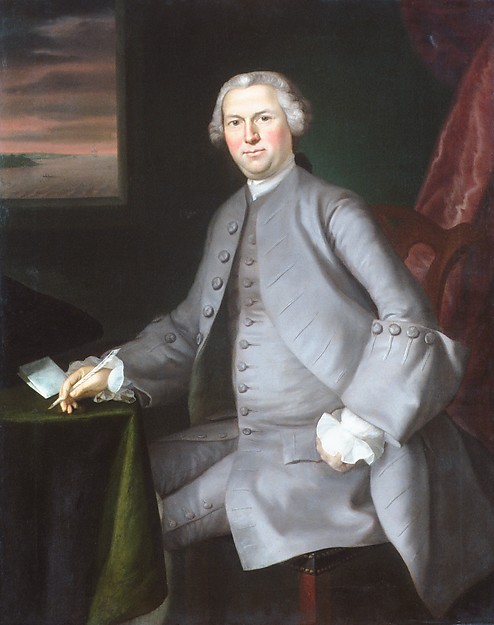
Because Joseph Blackburn painted in multiple sites across the American colonies, his paintings elucidate the ways that groups formed both local and imperial connections through recognizable physical markers. Blackburn’s portraits functioned simultaneously in two spheres: even as the portraits enabled local adherents to recognize a shared sensibility, binding people into provincial communities, the depictions also contained stylistic cues that incorporated patrons into a transatlantic community of English taste and manners.
All of Blackburn’s North American depictions share an allegiance to the style of portraiture popularized in 1740s London (then art center of the British Empire). Such paintings relied upon poses familiar from the circulation of British mezzotints, which meant that elites could grasp them immediately in different venues. The portraits were appealing because of their clear roots in London, but they were also recognizable from similar works undertaken in other transatlantic North American ports. The portraits Blackburn painted in Bermuda bear strong compositional and thematic similarities to the paintings he completed in other locations. The artist’s portrait of Rhode Islander John Brown recalls his depiction of Bermudian Francis Jones in the paintings’ shared emphasis upon merchants’ composition of letters. Blackburn’s portrait of Boston merchant Samuel Cutts bears an even closer resemblance to Jones’s portrait. Cutts is positioned almost identically to Jones, seated in front of a table with quill in hand about to write a letter, and, as in Jones’s portrait, Blackburn pictures one of the merchant’s ships visible through the window behind the sitter.
Joseph Blackburn’s Bermuda and New England portraits share compositional elements, but they also bear distinctive inflections that indicate the island’s residents required the artist to modify his approach. At the same time he offered his patrons depictions that adhered to transatlantic parameters of style, Blackburn tailored his portraits to local communities, enabling him to win success in different markets. This is especially visible in Blackburn’s pendant portraits of Bermudians John Pigott and his wife, Fannie Jones Pigott (Francis Jones’s daughter). Unlike his New England or even his English depictions, Blackburn’s portrait of Fannie Jones Pigott features prominently native flora and fauna. The artist included a palmetto in the back left of the painting as well as a Bermuda bluebird that perches upon the sitter’s outstretched finger. Species indigenous to the island, both palmetto tree and bluebird were likely previously unknown to the English painter, yet they had great significance for Bermudian viewers as key elements of their island’s renowned Edenic bounty.
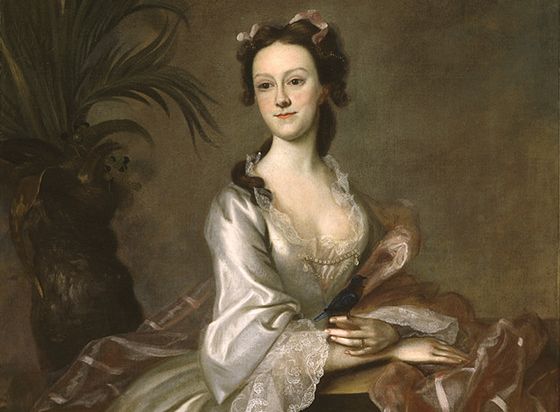
The bird and palmetto may point to Fannie Pigott’s avocation of natural history or her interest in conservation, pursuits shared with other residents. As early as the 1690s, Bermudians became aware of the damage inflicted upon their island’s natural landscape by deforestation, overfarming, and indiscriminate fishing, and they worked to restore and protect indigenous plants such as the palmetto. The palmetto proved a significant crop for Bermuda’s export market as local women wove palmetto leaves into baskets and bonnets that they then sold to English and North American buyers. Because palmetto craft production was often the province of elite merchants’ and planters’ wives and daughters, Blackburn’s portrait may also celebrate Fannie Pigott’s supervisory role in the weaving of palmetto products for export.
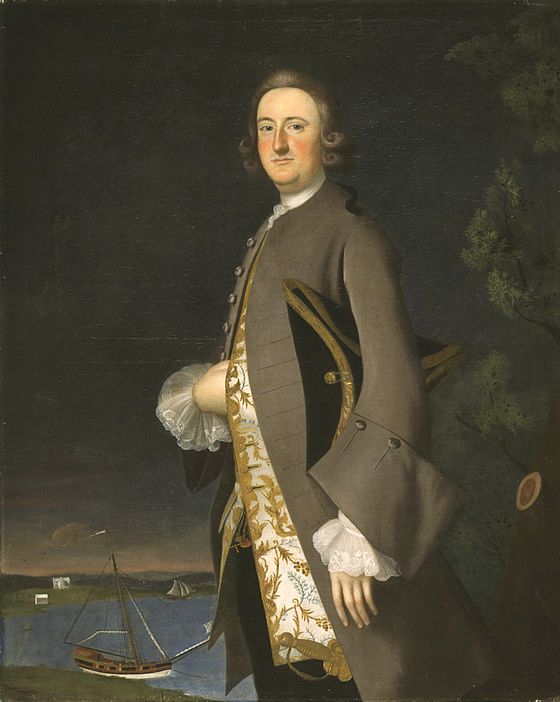
The artist’s depiction of John Pigott, collector of customs, includes similar local symbols that were important as markers of Bermudians’ shared commercial endeavors. Two vessels are visible in the painting: the ship close to the shore is about to be loaded or unloaded while a second in the distance has full sails ready to depart the port. Both ships are Bermuda sloops, a distinctive type of craft built on the island and sold to merchants around the Atlantic. Bermuda sloops became famous for their fast speeds, made possible in part through the use of lightweight Bermuda cedar in their construction. Indeed, in his portrait of Pigott, Blackburn prominently positioned a Bermuda cedar tree beside the merchant. One of the evergreen tree’s branches has been cut, showcasing the remarkable moisture- and insect-resistant red wood. The house visible on the far shore, which may be Pigott’s residence, suggests the material success Bermuda sloops made possible. This vernacular form, known as the Bermuda House, is also specific to the island. The building’s hipped roof and white limestone walls rendered it distinct from the houses that gentry constructed in other North American ports.
Once displayed in the Pigotts’ house, Blackburn’s portraits projected the sitters’ gentry standing, their mercantile connections, and their knowledge of local commodities to acquaintances, visitors, and the family members themselves. By portraying their pursuit of intercolonial trade in a Bermuda sloop, their construction of a house in the common vernacular style, and their devotion to the island’s flora and fauna, the Pigotts’ portraits declared their allegiance to the island and to the shared material strategies that Bermudian elites were then adopting. The paintings reveal a complex interplay between provincial and metropolitan culture. Blackburn articulated the Pigotts’ social prominence in a visual language that other transatlantic elites understood while also creating a sensus
Joseph Blackburn was not alone in realizing that patrons in different North American ports shared preferences for certain modes of portraiture. The works of John Wollaston, a British painter who, like Blackburn, worked in several North American locations, exhibit similar divergences. In New York City, Wollaston produced conservative portraits of women wearing idealized but fashionable dress, such as his circa 1751 portrait of Mrs. William Axtell. Indeed, almost without exception, Wollaston’s New York portraits show his female sitters wearing seemingly identical blue dresses festooned with white lace cuffs, their shared dress demarcating their common sensibility. In Charleston, South Carolina, however, Wollaston adopted a radically different type of depiction for female sitters: the masquerade portrait. This format is typified by Wollaston’s 1767 portrait of Charlestonian Ann Gibbes grasping a black mask and wearing “vandyke” dress, a popular type of masquerade costume. Wollaston painted Charleston women exclusively in these fictitious clothes popularized by London masqueraders and immortalized in Londoners’ portraits yet not worn in the British North American colonies, where the public masked ball did not gain prominence until well after the Revolution.
These local communities of taste to which artists adapted the pictorial language of the metropole transcended the genre of painting to shape other material choices that consumers made in port cities. Charleston, in particular, emerged in travelers’ accounts as a distinctive venue of patronage and consumption. As one 18th-century observer of the city noted, “The manners of the inhabitants of Charleston are as different from those of the other North American cities as are the products of their soil . . . there prevails here a finer manner of life.” Because “there were neither domestic circumstances to stand in the way nor particular religious principles, as among the Presbyterians of New England or the Quakers of Pensylvania, to check the enjoyment of good-living,” he discovered “their manner of life, dress, equipages, furniture, everything denotes a higher degree of taste and love of show, and less frugality than in the northern provinces.”
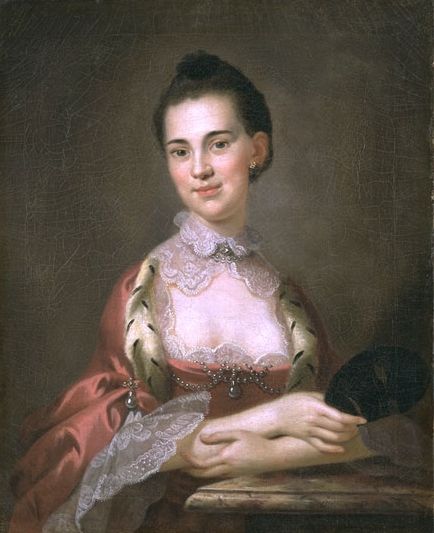
Although John Wollaston’s luxurious portrait of the young Ann Gibbes dressed for the masquerade seems to support this assessment of Charleston as a homogeneous society, Gibbes’s seductive pose suggests a disturbance in Charleston’s harmonious facade. Like colonists in other port cities, Charlestonians grappled with performing their urbanity on a transatlantic scene while shaping their material practices to support an emerging provincial culture. Charleston consumers deviated from both
Though their regional differences might have been readily graspable by observers, provincial networks of goods were still fragile, shaped as much by troublingly proximal African American and native American material practices as they were by London examples. In formulating their particular aesthetic communities, provincial elites, like Wollaston and Blackburn’s patrons, not only took cues from the high-style solutions generated in the metropole but also responded to (what they viewed as) the threatening counterexamples provided by native Americans and African Americans.
As they formulated ideas of savagery, colonists drew upon the contrast between a civil society and a state of nature that philosopher John Locke laid out in Two Treatises of Government (1689), a text fundamental to early Americans’ political and social understanding. Native American culture typified the state of nature that, to colonists, meant physical force determined survival, violence was endemic, and property was constantly under attack. Provincial elites trusted that by preparing a public self for communal interaction, they instituted a mutually beneficial society in which acts of violence diminished and savagery could be kept at bay. Their networks of things were more than a simple veneer of purchases that communicated politeness; assemblages erected barriers that provided a means of distinguishing between “us” and “them” and of combating those who failed to join the emerging cultural commonwealth.
As Samuel Johnson described in his dictionary, civility necessitated a “Freedom from barbarity.” Johnson’s young companion, James Boswell, further articulated that being civil entailed being “opposed to barbarity,” a reorientation of the self against an imagined other. Yet lurking within the inner self was savagery, to be hidden or tamed. Fear of the other was really Anglo-Americans’ fear of the savagery barely contained within themselves and provoked by the presence of Indians or African Americans.
A focus on material things highlights the racialized nature of provincial society. Native Americans and African Americans were conspicuously absent from Blackburn’s or Wollaston’s paintings and were similarly barred from communal life. Politeness was not a strategy that could be fully adopted by anyone. Colonial and metropolitan authors and policymakers not only condemned African Americans and native Americans as barbaric and childlike peoples, denying them the right to become cultured through object use, but women, too, had a contested relationship with civility, illuminating the gendered fractures within these collectives. On the one hand, political treatises, scientific discourses, paintings, and engravings inculcated ideas about women’s vulnerability to the perils of a North American environment and their precarious use of luxury goods; like savages, they
Though not fully included in political society, women were vital participants in making a civil order. If used correctly, certain objects enabled women to suppress their passions, demonstrating their potential importance for the achievement of community--even as the necessity for such goods highlighted women’s vulnerability without them. It is no coincidence that both Blackburn’s and Wollaston’s portraits of female sitters show the greatest regional variation. Women were viewed as the most manipulable of its residents, which turned them into the barometers of a society’s politeness, able to be deployed as symbols of local taste.
Objects matter in the pages that follow. Their materiality; the formal qualities of color and texture and properties of paint, paper, and wood; the overall composition, massing, and organization of forms--each of these factors leaves traces through which the actions of past creators and users can be recovered. Objects are physical things, but they are also things to think with, things that, through their very material presence, simultaneously encapsulate multiple symbols and conjure varying resonances. To get at this metaphorical function of the object, I often rely upon satire and humor, poetry and metaphor, as a means to resuscitate patterns of behavior and belief that were unspoken yet fundamentally shaped peoples’ relationships with one another and with the material world. New technologies of humor and fiction formed alongside emerging ideas about the nature of the self in the eighteenth century. No longer able to conceive of selfhood as a series of fixed ranks and stations, as had been the case in previous eras, early Americans did not yet envision the self to be a reservoir of interior and invisible character, as moderns would.
Instead, eighteenth-century residents of the British Atlantic world expected identity to be visible and flexible and assumed that even seemingly fixed characteristics, such as gender and race, might be manipulated or altered through changes in costume or climate. In part, these beliefs stemmed from the tremendous popularity of Locke, who argued in An Essay concerning Human Understanding (1689) for a mutable self that was heavily influenced by exterior environment. Charlestonian Eliza Lucas Pinckney, writing to a friend in 1741, indicated both her conversance with Locke’s writings and her sense of a self that was constantly in flux. When she returned from Charleston to her plantation, Pinckney related that “everything appeared gloomy and lonesome,” but she realized the “change” could be found “not in the place but in my self.” She was then “forced to consult Mr. Lock over and over to see wherein personal Identity consisted and if I was the very same self.”
Though made slightly tongue-in-cheek, Pinckney’s reflection demonstrates her use of the material goods around her to stabilize her sense of self; distraught, she looked to the reliable architecture of her plantation and the well-thumbed pages of Locke’s essay to
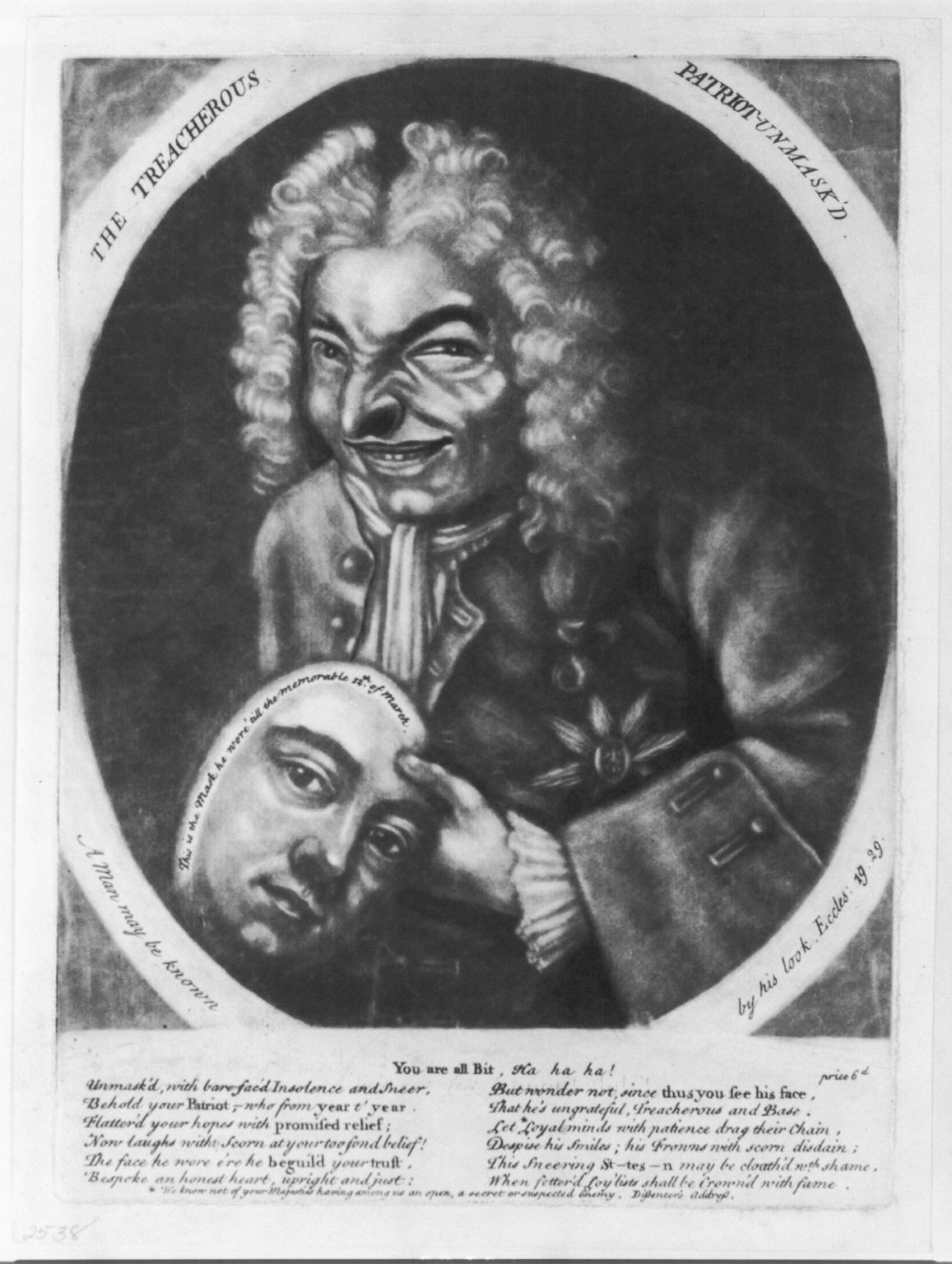
As residents of the British Atlantic world struggled to fix interior character to exterior appearance and to establish material artifacts’ place in shaping identity, they embraced the novel, along with satire and caricature. Under the satirist’s or the novelist’s pen, a character’s true intentions could be made visible. Likewise in the midcentury explosion of satirical prints and caricatures that poured out of London to all corners of the Atlantic world did artists find a new means to observe the disjuncture between a subject’s appearance and actions. The anonymous engraver who created The Treacherous Patriot Unmask’d in 1742 commented directly on the misalignment between outward appearance and inner motivation. The smooth-speaking politician is here revealed to be a sneering and selfish man. He has pulled off his pleasant face (represented as a mask) to show his true nature, typified by the wizened, grotesque physiognomy thus revealed.
As the caption cautions, “The face he wore . . . Bespoke an honest heart, upright and just: / But wonder not, since thus you see his face, / That he’s ungrateful, Treacherous and Base.” The printmaker has positioned the politician in a roundel, a format commonly used by portrait painters, and one can imagine that, with the subject’s pleasing facade in place, the print might well have resembled a portrait by Joseph Blackburn. Instead, the satirical engraving manipulates reality to show what is truly there but usually unseen. Rather than a force of grossness or indecency opposed to public life, humor was a fundamental means for polite peoples to reaffirm their ideas of character and to question artifacts’ place in their daily lives.
As colonists prepared themselves to engage in social relationships, they assembled a multiplicity of types of things, from pieces of costume to furniture to paintings. Joseph Blackburn’s sitters, for instance, did not commission their portraits and then sit back confident that these possessions marked them irrevocably as polite. Instead, they deployed a network of artifacts to shape their social identities. To trace the actual collectives that people formed with things, then, requires uniting objects that people used and owned in the past rather than differentiating distinct types of artifacts by medium, genre, or connoisseurship. Placed alongside one another, engravings, portraits, gravestones, dressing furniture, and prostheses capture the heterogeneity of artifacts that comprised colonial assemblages and yet illuminate the commonality of purpose such goods shared in forming provincial society.
Chapter One examines a series of monumental prints of the cities of Boston, New York, Philadelphia, and Charleston. Sponsored and purchased by subscribers in each port, these engravings offer a traceable sequence of the associations formed through their commissioning and display. Considering these prints’
The third chapter turns to the city of Charleston, South Carolina, and follows residents’ formation of networks into the city’s cemeteries to analyze a group of unique tombstones that continued to unite Charlestonians beyond the boundary of life. Carved with portraits of the deceased in the Boston area, the memorials were erected in South Carolina churchyards in the middle of the eighteenth century. By eternally linking a mimetic, but highly idealized, representation of the body to the corpse, portrait gravestones enabled elite Charlestonians to maintain the boundaries between themselves and the savage others with whom they lived, even as their bodies decayed. Just as important as the role these stones played in memorializing the dead were the bonds they forged with the community of the living who selected them. Because of their monumentality, these portrait gravestones offered Charleston’s elites a social collective with a degree of permanence that was otherwise unachievable in their disease-ridden environment; the stones rendered their social networks concrete for perpetuity.
Together, the first three chapters examine distinctive aesthetic communities created through the formation of provincial society in colonial ports around midcentury. The second half of the book follows these assemblages through the decades of imperial crisis and revolution as political and cultural tensions between colonies and metropole came to a head, and through the period of uncertain nation-building that followed. Whereas the first portion of the book examines objects that could be used by either sex, the last three chapters consider the gendered nature of civil life and the intimate networks that shaped early American communities. Chapter Four examines elite Charlestonians’ forging of bonds through marriage, the beginning point for mutual social identity. The chapter delves into
Extending analysis outward from Wollaston’s painting of canvases to elite women’s painting of their own faces, Chapter Five studies the dressing furniture used by women in Charleston and New York City during the years of the early republic. The heterogeneous assemblages of cosmetics, looking glasses, and textiles put into play on dressing tables’ surfaces encouraged women to ready themselves for the demands of republican responsibility. Seated in front of a dressing table, the user employed the brushes, pomades, and powders kept in its drawer to refine and polish; smoothing away moral imperfections by disguising bodily ones, she produced a persona oriented to her role in the new nation. Powders, pastes, and pomades might have enabled women to subdue passions and improve their beauty, but they also conjured fears that the user’s exterior appearances bore no relationship to her inner virtue, thus implicating dressing furniture in a larger debate over the potential for deception. Even as dressing tables effectively bound elites in Charleston and New York into a wider continental network, the role that women would play in the new republic remained in question, as did the reality of the social identities they burnished before their looking glasses.
Using a single artifact--the wooden leg donned by American statesman Gouverneur Morris--the sixth and final chapter illuminates that the most personal of networks (formed between a person and a prosthesis) undergirded the burgeoning ties of American citizenship. In particular, the chapter examines American leaders’ using the bodies of amputees to frame a new ideal of republican manhood. As Americans struggled to form a republic, they recognized that only a polite and able-bodied citizenry could achieve the virtue deemed necessary for citizenship. Yet the number of amputees created by battle left many citizens <“deformed” or defective, and therefore, in the eyes of their contemporaries, morally compromised. Prostheses offered a route to replace bodily lack by advertising patriotic integrity. Morris’s wooden
This was excerpted from The Power of Objects in Eighteenth-Century British America by Jennifer Van Horn. Published for the Omohundro Institute of Early American History and Culture. Copyright © 2017 by the University of North Carolina Press. Used by permission of the publisher. www.uncpress.org
